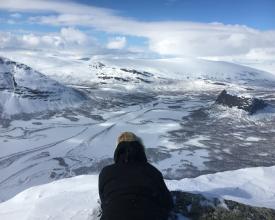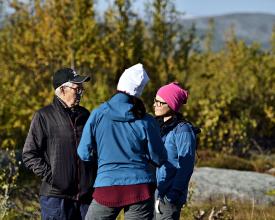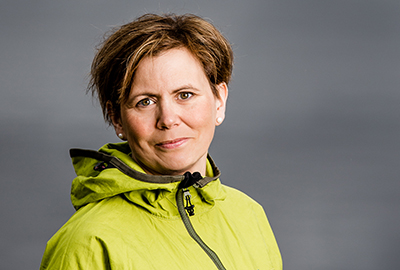
Laponiatjuottjudus: a participatory management system in the Laponian Area World Heritage, Sweden
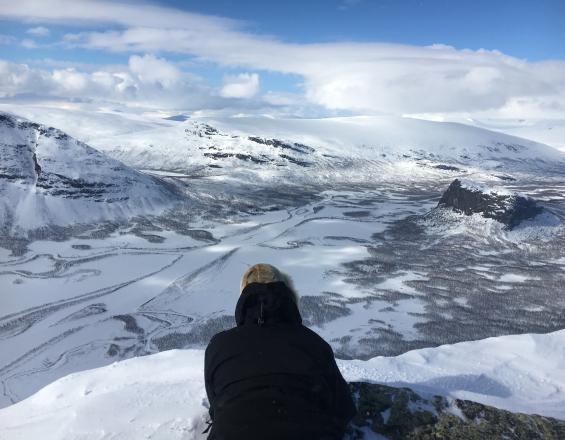
The Laponian Area was inscribed in 1996 in the World Heritage List under criteria (iii), (v), (vii), (viii) and (ix). It is composed of four national parks and two nature reserves containing two dominant landscape types: an eastern lowland comprising marshlands, hundreds of lakes, and mixed woodlands; and a western mountainous landscape with steep valleys and powerful rivers, which contains about 100 glaciers. This mosaic of protected areas is situated in Sápmi, region settled about 7,000-8,000 years ago, and used by Sámi people as summer-grazing areas for their reindeers for many generations, a culture which has shaped the landscape in a smooth way. In 2012, Laponiatjuottjudus was established to be in charge of the management of the property and the implementation of the management plan adopted in 2011, allowing an integrated management of cultural and natural values. This management board, composed in its majority by Sámi representatives, functions by consensus decision-making.
Context
Challenges addressed
The conservation of the region operated under the guidelines of national parks since the early 20th century and was largely associated with the image of wilderness prevailing in outsiders perspectives. The area is State-owned and conserved as natural protected areas, even though it has been fully used for reindeer husbandry and covers nine samebyar, reindeer herding communities and their territories. Furthermore, the area also comprises sacred places, important in traditional Sámi culture called sieidi, rock formations and reliefs that herders encounter when they move or migrate within their territories for reindeer transhumance. The establishment of the Laponiatjuottjudus (Tjuottjudus: to manage, administrate something) addresses this social challenge by enabling Sámi people to have some stewardship over the land, including the non-Sámi in the management so all stakeholders could value the World Heritage.
Location
Process
Summary of the process
The establishment of the Laponia Process (BB1) allowed for the dialogue to start between the diverse stakeholders involved in the management of the Laponian Area World Heritage property. This dialogue used traditional working methods for the decision-making process based on consensus (BB2). The involvement of the diverse stakeholders in the Laponia Process enabled the development of a participatory management plan (BB4), that through the creation of the Laponia Ordinance (BB3) granted the implementation of the plan and responsibility for the management of the Laponian Area World Heritage to the Laponiatjuottjudus.
Building Blocks
Establishment of an inclusive dialogue process: the Laponia Process
The Laponia Process was an approach to dialogue created and developed by a diversity of stakeholders in the Laponian Area World Heritage property. Since Laponia is a large area which consists of several protected areas, to establish a coordinated management system as a whole has been very challenging since its inscription in the World Heritage List. The County Administrative Board of Norbotten and the Sámi communities and municipalities of Jokkmokk and Gällivare started originally to prepare their conservation programs independently. The Laponia Process started by the initiative of the Governor of Norrbotten in 2005 including all stakeholders in a process of dialogue based on a set of common values, which would lead the parties to agree in crucial issues and the terms in which the Laponian Area should be managed. All decisions were determined to be taken by consensus, and new regulations for the national parks and nature reserves were requested. In 2006, the parties signed a common agreement which they sent to the Government, which contained:
- A set of common basic values
- Common intentions for a number of efforts
- The establishment of a temporary Laponia delegation
- Preparations for the start of a World Heritage management group with a Sámi majority on the committee.
Enabling factors
The political will of the Governor of Norbotten, the Sámi village organizations through the association Midjá Ednam, the interest of the municipalities of Jokkmokk and Gällivare, and the endorsement of the SEPA were essential conditions for starting the process. The initiative originates in the acceptance of the different realities of the parties involved and the strong will to co-create a new management for the Laponian Area. Moreover, there was enough financing for the project and each group participated with the same economical prerequisites.
Lesson learned
To be able to establish an organization based on consensus and develop a new way of management, one needs to listen to people and try to learn why they are thinking and doing like they are (it is norms and values that forms their ideas and practise) but also openly explain why one is thinking and doing in the way one is, because that also depends on the norms and values one has in life. This process takes time, and it is about learning new knowledge from each other and accept it. This is also a process one cannot do in the office, one needs to go out and meet people in their ordinary life regularly. It cannot be rushed or think it can be a quick fix. The Laponia Process took six years until all stakeholders involved could agree upon a common organization and management plan.
To do a process like the Laponia Process – you need to have time, financing, and the “right” people involved. Listen to each other. Time to take home tricky questions and discuss them with other representatives for the stakeholders, before decisions are made.
Integrating traditional working methods as a base for dialogue
The Laponia Process has used several traditional governance working methods. For instance, Rádedibme or councils have a central function in the management. These are open meetings held on important issues with the local population and diverse stakeholders, where local viewpoints and knowledge are expressed and taken into consideration for management. Searvelatnja means “learning arena” and is based on dialogue and learning. On a conceptual level this means that Laponia should be an arena where everyone can participate, a meeting place for several generations, cultures, languages and perspectives. By working together we learn from each other and share each other’s knowledge. How Laponia is to be managed is an ongoing process, where an unpretentious approach is adopted, in order to create a local management that integrates the interests of all parties concerned. Oassebielráde or Council of the Parties is the annual meeting for all the entities that manage the World Heritage property. This meeting does not appoint a committee: the parties themselves decide who will represent them in Laponiatjuottjudus. However, consensus is required when electing the chairperson. Consensus is sought as a process of joint decision-making where everyone must be in agreement before any decision is made.
Enabling factors
- Continuity of traditional both Sámi and non-Sámi systems of organization.
- Inclusion of Sámi communities and openness to use Sámi traditional knowledge.
- Openness and respect toward each other and the cultural background the representatives have.
Lesson learned
- If not every stakeholder is invited from the beginning, there will not be any solution. It is not possible to present ready-made solutions to one stakeholder and think they will accept it. Every question and challenges that arise must be managed together.
- Have a common goal: for the stakeholders in the Laponia Process, the common goal was to find a solution how to manage the World Heritage. The goal must be clear, so every stakeholder knows what the goal is.
- Listening and learning from each other. It is about to take and give all the time. Even if people do not act the way one is used to, one has to accept it and hopefully learn something from it.
- It is important that the representatives from each stakeholder is giving the right message to the stakeholders' group he or she represents, otherwise people may be disappointed in the long run.
- There is no meaning in rushing through a process like the Laponia process.
Adopting an enabling legal framework
In order to grant the management responsibility to a local entity, a new legal framework had to be created. The Laponia Ordinance is the only legislation applying to a World Heritage Site in Sweden. It enables the County Administrative Board and the Environmental Protection Agency to hand over responsibilities to Laponiatjuottjudus. In normal cases it is the municipalities or the County Administrative Board that administrate a new World Heritage Site.
Enabling factors
- A willingness from the authorities to try new solutions in management.
- Not to be afraid to think outside the box.
- A willingness to compromise.
Lesson learned
It is really hard to give recommendations how stakeholders in other countries should work with a similar process, because so much depends upon the situation in the country, how the relationship between the different stakeholders, inhabitants in the area, is. It is necessary to understand well which possibilities the government, authorities, and local people have to participate in a process such as the Laponia Process.
It is fundamental to know what is possible to do with the legal framework because the proposal must be compatible with the rest of the country’s legal framework.
Development of a participatory management plan
The parties of the Laponia Process envisioned to create a new management plan for the property using the values within three areas: the natural environment and its high values; the living Sámi culture and reindeer industry; and the historical heritage arising from previous usage of the land. This participatory management plan is based on a shared understanding of the World Heritage property by all stakeholders involved in the process and the implementation of the plan. Besides the governing institutions (municipalities, county, governmental agencies in charge of heritage conservation), important stakeholders to be considered and integrated in this participatory process are the Sámi villages which are organizations responsible for the reindeer husbandry within a specific area. It is a legal entity and they are organized through village meetings.
Enabling factors
- The platform for dialogue created with the Laponia Process.
- Reindeer Husbandry Act (member of a Sámi village organization).
- The constitution provides special protection to Sámi people and their rights.
- The Sámi are the Indigenous people of Sweden (determined by the Parliament) which gives them a special legal status in Swedish law.
- The Right of Public Access.
- Willingness from the authority to try something new, new working methods for management.
Lesson learned
Management plans where different stakeholders have to compromise all the time might be too unspecific. There can be themes in the management plan that the organization have no prerequisites to implement and then people will be disappointed if the organization is not working with them. For instance, in our management plan, there are sentences that state how we should be working with the Sámi language, and therefore, we are doing it to some extent. But language is not our main focus and then sometimes people may be disappointed with the results.
Impacts
- Laponian Area World Heritage Participatory Management Plan including Sámi and local values.
- The different parts in Laponiatjuottjudus have agreed upon that they do not have a common opinion regarding the ownership of the area inside the World Heritage.
- More people feel included in the management of Laponia and that they have a possibility to influence what Laponiatjuottjudus should be working on – the World Heritage is theirs.
- Strong decision-making process involving people, learning by doing, and the possibility to try new solutions based upon local and traditional knowledge.
- A system which is working with values and questions that are closely connected to the people, see the people and what they are interested on (not so bureaucratic as an ordinary authority).
- Decision-making close to the local people.
Beneficiaries
Sámi and non-Sámi local peoples
Sustainable Development Goals
Story
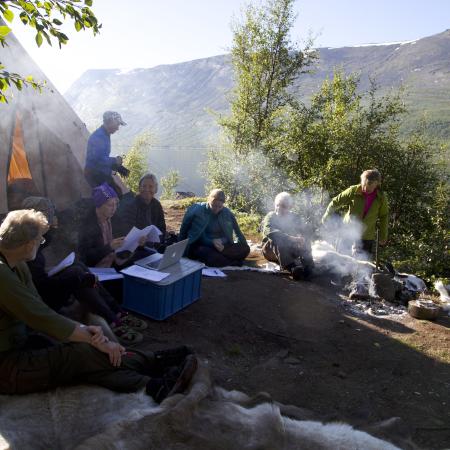
As the site manager of the Laponian Area, I need to take decisions everyday regarding the conservation of the World Heritage property. Whenever there is an emergency, I am the first to be informed and need to coordinate the response.
Some years ago, there was a forest fire in Laponia. The rescue team called me late during the evening and informed me about the situation, and that they could not do anything about it that evening because it was too dark outside. They said they were heading up there the next day in the early morning. I summoned representatives of the board and informed them about the situation. After the meeting, I also contacted the head of the Sámi village where the forest fire was situated. He already knew about it because he was in that area working with the reindeers. Later on that evening he called me back, and said: "If you are at that place at 7 o’clock in the morning, we will pick you up in the helicopter, so you can see where the forest fire is, because we will be flying in the area, we are working with the reindeers there”. In the early morning, I was at the pick-up place and we flew away with the helicopter. After a while, the head of the Sámi village, said to me: “This is the difference between the management in the old way through Swedish authorities and Laponiatjuottjudus. Now we are involved in the management and need to take responsibility for the work. To be able to take the right decisions about this forest fire, you must have a possibility to see it from above. That is why I asked you to follow us in the helicopter today".
This is one of the main impacts of the Laponiatjuottjudus: local people feel responsible for the World Heritage site and feel that they can contribute. Especially in an emergency, this can be crucial. (Åsa Nordin Jonsson, Laponia World Heritage Site Manager)

